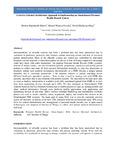A Service Oriented Architecture Approach to Implementing an Omnichannel Personal Health Record System

View/
Date
2021-06Author
Kipchirchir, Hesbon Kiptoo
Nzyoka, Benard Mutisya
Mugo, David Muchangi
Metadata
Show full item recordAbstract
Interoperability of eHealth systems has been a problem that has been unresolved due to
variations in platforms, protocols, data formats, patient matching criteria and lack of universal
patient identification. Most of the eHealth systems are owned and controlled by individual
hospitals and not exposed to other third parties by choice or fear of losing competitive advantage
when they share with other institutions The popular Personal Health Record (PHR) systems,
instead of patient centric, are also institution-specific, proprietary, expensive and mostly permit
patients to collect and enter all their medical information manually as only few physicians or
hospitals submit their medical information electronically to a PHR. Having a unique patient
identifier that is consistent nationwide is the ultimate solution to patient matching across
different healthcare provider‟s systems. There is also a need to manage and avail PHR data
anytime, anywhere and to any terminal with patient consent. The data need to be kept up to date
as soon as medical information is available preferably automated upload from EMR or in real time from monitoring devices through open APIs. We thus designed an Omnichannel PHR
solution based on Service Oriented Architecture to enable patients to sign up, manage profile and
share medical information through cross platform mobile application, web application and
monitoring devices in real time. IBM‟s Service Oriented Modelling and Architecture (SOMA)
phases was used to model, identify, select, implement, deploy and monitor the services in the
Omnichannel PHR solution. The main goal of using SOA was to provide consistent services
across all channels, terminals or devices. This research therefore recommends open APIs using
SOA for central identification and management of personal health records, use of open source
technologies and adoption of Internet of Things to collect vital patient medical information in
real-time.
